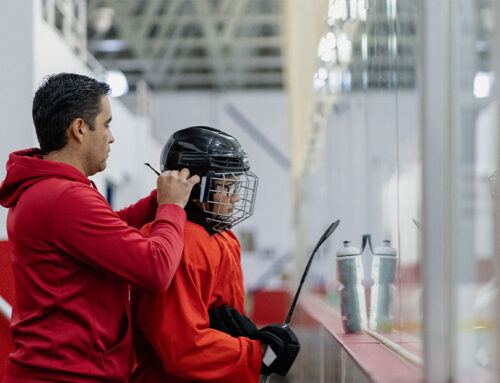CatcherMtrx Training Tool, Part 1: The Ultimate Catcher’s Workout
Be the athlete and leader you’ve always wanted to be as your team’s starting catcher with the Catchermtrx training tool from Athelite Player Development. A total training package, endorsed by D-I college coaches and professional ballplayers, the program is a step-by-step breakdown of all important aspects of a catcher’s game. Created with the serious ballplayer in mind, Catchermtrx puts a twist on typical catching drills by combining receiving, blocking, and throwing exercises and coupling them with intense plyometric drills.
Four components make up the Catchermtrx training tool:
- Catching fundamentals/creating body awareness with help from Phillies scout Tom Downey
- Conditioning/strength training program for in-season and off-season, created by D-I strength coach Richard James
- On-field thought processes like quick decision-making, building leadership qualities and emotion control
- Developing “field vision”: how to view specific runners, hitters, picking out a team’s weaknesses and knowing how to look for those traits
We’ll start the first article in this 4-part series with a blocking program. (See also Block More Pitches With These Catching Drills.)
CatcherMtrx Drill 1
Sets/Reps: 2×12-15 from direct fastball. (Right with curve/Righty Curveball and Left with curve/Lefty Curve)
- Begin on your knees with your hands behind your back. This position will make sure that your catcher will not cheat to block the ball. Although there is no “perfect” blocking position, we like to train the mind of the catcher to get to a familiar position and then adjust to unfamiliar movements. But we must create good muscle memory to allow consistency in their movements.
- Partner stands 15 feet away slowly rolling the ball to the middle zone. The “role” here is to replicate a pitch while allowing the drill to be under a controlled atmosphere to assure quality reps.
- As the ball reaches the block zone, track the ball through the hitter’s zone and stop it with the cage or front part of your helmet. Be sure to not substitute speed for mechanics. As you become more familiar with this drill, speed and distance will be added to get up to “game speed.”
To replicate a curve ball:
- Complete the same drill as above, but this time partner puts a slight curve on the roll as if he/she were bowling. To simplify the direction of the curved ball, stand on a slight angle so the catcher can see the different directions of the pitched/rolled ball. As you get closer to the season and more comfortable with these movements you can add speed and distance.
- Focus on good timing to ensure the blocked ball can be recovered and you can make a strong accurate throw to the base of choice. Without good timing on a blockable pitched ball, all mechanics mean nothing. So be sure to start your block at the correct time.
CatcherMtrx Drill 2
Sets/Reps: 2×10
Increase distance and sets as catcher becomes better at this drill
- Create an 8×8-foot boundary box with cones directly in front of home plate. This is to make sure the blocked ball doesn’t get too far away from the catcher so that the runner will/can advance with ease.
- Start in blocking position, glove down and bare hand protected. This position and movement are similar to the drill above. The only noticeable difference is that you will protect the hole between your knees with your catcher’s mitt and your right hand protected by the catcher’s mitt.
- Partner kneels on one knee 20 to 30 feet away from home plate. This is to assure a controlled drill atmosphere to gain confidence with success on each repetition.
- Partner throws short hop to catcher’s hop zone. The thrower must create quality short hops into the blocking zone. This drill is based on of how well the thrower can produce disciplined blockable throws.
- When ball hits the hop zone, block it: create a C-wave over the ball while trying not to allow it to leave the boundary box. As the ball approaches the block zone, allow it to enter your C wave at the correct time to maximize the chance of stopping the blocked ball into your (8×8) box.
- Each time the ball leaves the boundary box, both thrower and blocker do 15 Push-Ups. This will assure that both the catcher and thrower are taking the drill seriously.
CatcherMtrx Drill 3
Sets/Reps: 3x1st base, 2nd base and 3rd base
Perform the same movements as Drill Two, but when you block the ball, recover it and throw to each base. The pace of the drill is determined on how fast or slow the coach would like to approach it. Early in the season, we recommend a slow backwards walk, gradually getting into a slow jog as the season goes on.
CatcherMtrx Drill 4: Point, Block and Recover
- This drill is done on a foul line from home plate to either 1st base or 3rd base. Do not allow this drill to go on too long, because it is a strenuous movement; and as fatigue sets in, the quality of reps will decrease.
- Start over home plate in secondary position (i.e., man-on-base position) facing corner base. Direct all blocked balls back to the baseline to assure correct direction for recovery.
- Coach stands 5 feet in front with a bat for pointing. Be sure that the bat is long enough so that you do not interfere with the drill quality.
- Coach slowly and gradually walks backward, pointing to a spot where he wants his catcher to block the ball. Give a variety of different angles and blocking positions.
- Catcher blocks to that spot and recovers as quickly as possible while transitioning to power throwing position. This is a key part of the drill. The recovery is just as important as the actual block. Once the ball is correctly recovered, catcher gets to a correct “strong position” to assure the correct direction on the throw. This movement is the bridge between the block and throw.
- Catcher should be in constant motion until he reaches a corner base or until movements start getting watered down in quality. Some catchers will be able to go the foul pole and others only 10 feet. The coach needs to be the judge of that. The discipline of the movements will tell the story!
RECOMMENDED FOR YOU
MOST POPULAR
CatcherMtrx Training Tool, Part 1: The Ultimate Catcher’s Workout
Be the athlete and leader you’ve always wanted to be as your team’s starting catcher with the Catchermtrx training tool from Athelite Player Development. A total training package, endorsed by D-I college coaches and professional ballplayers, the program is a step-by-step breakdown of all important aspects of a catcher’s game. Created with the serious ballplayer in mind, Catchermtrx puts a twist on typical catching drills by combining receiving, blocking, and throwing exercises and coupling them with intense plyometric drills.
Four components make up the Catchermtrx training tool:
- Catching fundamentals/creating body awareness with help from Phillies scout Tom Downey
- Conditioning/strength training program for in-season and off-season, created by D-I strength coach Richard James
- On-field thought processes like quick decision-making, building leadership qualities and emotion control
- Developing “field vision”: how to view specific runners, hitters, picking out a team’s weaknesses and knowing how to look for those traits
We’ll start the first article in this 4-part series with a blocking program. (See also Block More Pitches With These Catching Drills.)
CatcherMtrx Drill 1
Sets/Reps: 2×12-15 from direct fastball. (Right with curve/Righty Curveball and Left with curve/Lefty Curve)
- Begin on your knees with your hands behind your back. This position will make sure that your catcher will not cheat to block the ball. Although there is no “perfect” blocking position, we like to train the mind of the catcher to get to a familiar position and then adjust to unfamiliar movements. But we must create good muscle memory to allow consistency in their movements.
- Partner stands 15 feet away slowly rolling the ball to the middle zone. The “role” here is to replicate a pitch while allowing the drill to be under a controlled atmosphere to assure quality reps.
- As the ball reaches the block zone, track the ball through the hitter’s zone and stop it with the cage or front part of your helmet. Be sure to not substitute speed for mechanics. As you become more familiar with this drill, speed and distance will be added to get up to “game speed.”
To replicate a curve ball:
- Complete the same drill as above, but this time partner puts a slight curve on the roll as if he/she were bowling. To simplify the direction of the curved ball, stand on a slight angle so the catcher can see the different directions of the pitched/rolled ball. As you get closer to the season and more comfortable with these movements you can add speed and distance.
- Focus on good timing to ensure the blocked ball can be recovered and you can make a strong accurate throw to the base of choice. Without good timing on a blockable pitched ball, all mechanics mean nothing. So be sure to start your block at the correct time.
CatcherMtrx Drill 2
Sets/Reps: 2×10
Increase distance and sets as catcher becomes better at this drill
- Create an 8×8-foot boundary box with cones directly in front of home plate. This is to make sure the blocked ball doesn’t get too far away from the catcher so that the runner will/can advance with ease.
- Start in blocking position, glove down and bare hand protected. This position and movement are similar to the drill above. The only noticeable difference is that you will protect the hole between your knees with your catcher’s mitt and your right hand protected by the catcher’s mitt.
- Partner kneels on one knee 20 to 30 feet away from home plate. This is to assure a controlled drill atmosphere to gain confidence with success on each repetition.
- Partner throws short hop to catcher’s hop zone. The thrower must create quality short hops into the blocking zone. This drill is based on of how well the thrower can produce disciplined blockable throws.
- When ball hits the hop zone, block it: create a C-wave over the ball while trying not to allow it to leave the boundary box. As the ball approaches the block zone, allow it to enter your C wave at the correct time to maximize the chance of stopping the blocked ball into your (8×8) box.
- Each time the ball leaves the boundary box, both thrower and blocker do 15 Push-Ups. This will assure that both the catcher and thrower are taking the drill seriously.
CatcherMtrx Drill 3
Sets/Reps: 3x1st base, 2nd base and 3rd base
Perform the same movements as Drill Two, but when you block the ball, recover it and throw to each base. The pace of the drill is determined on how fast or slow the coach would like to approach it. Early in the season, we recommend a slow backwards walk, gradually getting into a slow jog as the season goes on.
CatcherMtrx Drill 4: Point, Block and Recover
- This drill is done on a foul line from home plate to either 1st base or 3rd base. Do not allow this drill to go on too long, because it is a strenuous movement; and as fatigue sets in, the quality of reps will decrease.
- Start over home plate in secondary position (i.e., man-on-base position) facing corner base. Direct all blocked balls back to the baseline to assure correct direction for recovery.
- Coach stands 5 feet in front with a bat for pointing. Be sure that the bat is long enough so that you do not interfere with the drill quality.
- Coach slowly and gradually walks backward, pointing to a spot where he wants his catcher to block the ball. Give a variety of different angles and blocking positions.
- Catcher blocks to that spot and recovers as quickly as possible while transitioning to power throwing position. This is a key part of the drill. The recovery is just as important as the actual block. Once the ball is correctly recovered, catcher gets to a correct “strong position” to assure the correct direction on the throw. This movement is the bridge between the block and throw.
- Catcher should be in constant motion until he reaches a corner base or until movements start getting watered down in quality. Some catchers will be able to go the foul pole and others only 10 feet. The coach needs to be the judge of that. The discipline of the movements will tell the story!











